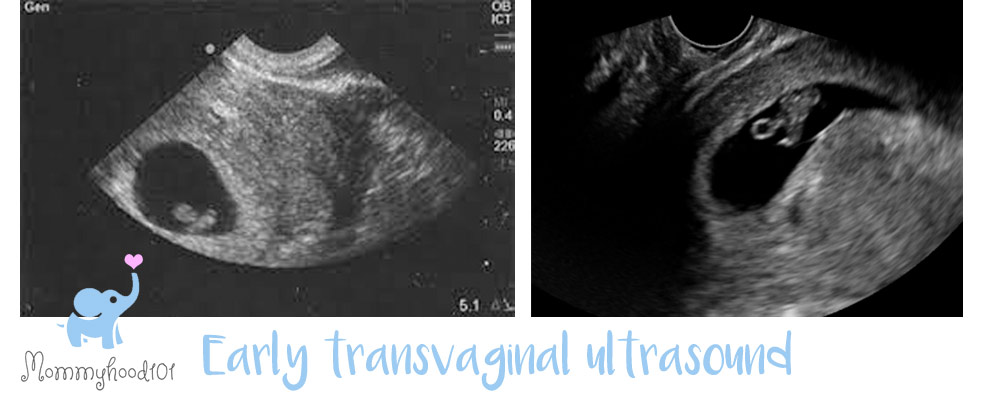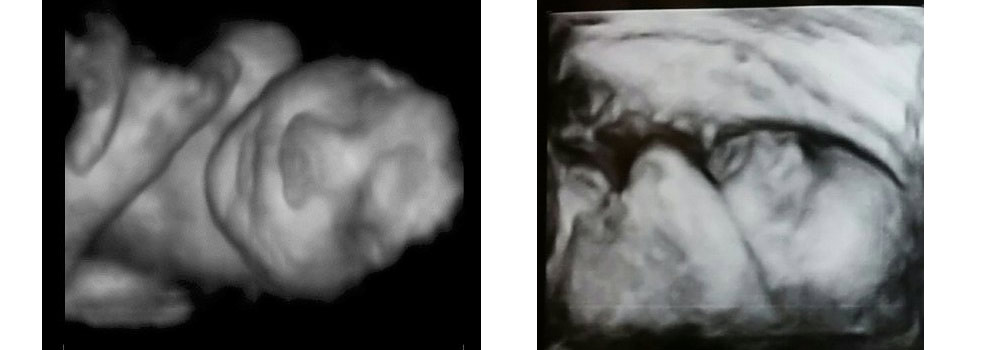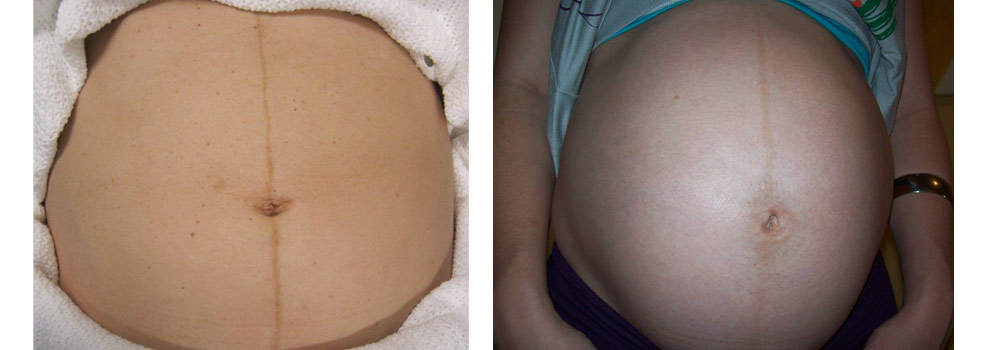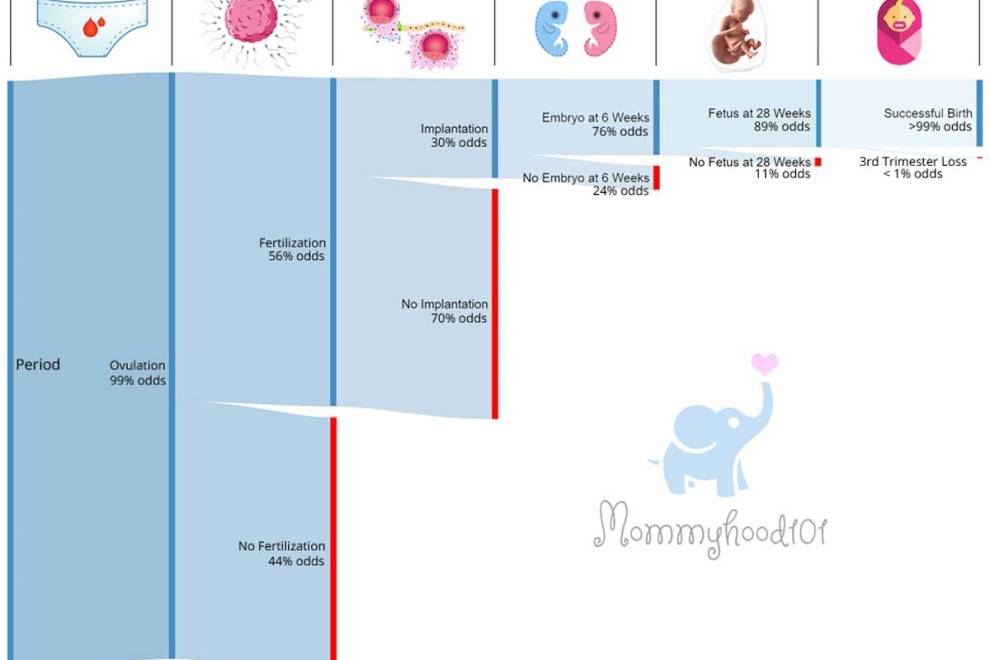The Second Trimester of Pregnancy: What to Expect
From baby kicks to baby bumps - what to expect during the second trimester.

Mommyhood101 independently tests and curates baby gear to help you make informed decisions. If you buy products through links on our site, we may earn a commission.
During the second trimester of pregnancy, your baby will increase in size and weight from about the size of a lime (and about 3 ounces in weight) to the size of a small eggplant or football (and up to about 2 pounds in weight).
This amazing transformation of size is accompanied by several changes to your body that you should be prepared for, and not just the increasingly prominent belly bump!
- Jump back to First Trimester
- Important Terms & Definitions
- Second Trimester: Month 4
- Month 4 Development
- Month 4 Pregnancy Symptoms
- Second Trimester: Month 5
- Month 5 Development
- Month 5 Pregnancy Symptoms
- Second Trimester: Month 6
- Month 6 Development
- Month 6 Pregnancy Symptoms
- Sources & References
- Jump to Third Trimester
Table of Contents
Click on any month to jump to that section, or simply start reading! You can also print this article for some bedtime reading for you and your loved one!
Every woman will experience pregnancy and the second trimester differently. You might experience some of these symptoms very strongly, and others might be a blip on the radar.
Still others might not notice any symptoms at all! That's completely normal because every woman's body is unique, responding in its own way to the hormonal, metabolic, and physiological changes that occur during pregnancy.
Pregnancy: Important Definitions
Before we describe what happens during pregnancy, let's cover some basic terms that are important to know, especially when communicating with your doctor.
What is an Ultrasound? The ultrasound involves sending sound waves into your body and measuring how the sound gets reflected back by different types of tissue. While the ultrasound uses sound, it's too high frequency for humans to hear (including your baby!). The reflected sound waves get converted into a picture that helps the ultrasound technician see, inspect, and measure your developing fetus.
There are two primary ways to perform a pregnancy ultrasound. The first is an abdominal ultrasound, involving rubbing the ultrasound wand across the belly: the ultrasound technician will put a special jelly on your stomach and then rub the wand around to get a good view of your fetus. But if the fetus is too small or hard to see, the second method is called a transvaginal ultrasound. This is more invasive and involves sliding the ultrasound probe into the vagina. Don't worry too much, the wand is very thin and a lot of lubrication is used!
The earlier the first ultrasound is done, the more likely the doctor will use the transvaginal method (Ref 1). If scheduled later, like around 11-13 weeks, it is more likely that your doctor will be able to use ultrasound on your abdomen. Ultrasound allows the technician to take accurate measurements of fetal morphology (shape and size), and physiology (heart rate), and is used early on in a pregnancy to calculate an accurate fetal age and due date.

What is a Blood Test? The blood test involves using a needle to draw blood from a vein in your arm, and then sending the tube of collected blood off for testing. Most obstetricians and gynecologists (OB/GYN) will schedule a series of blood tests during the second trimester. This is called a multiple marker test, because it can allow for screening of multiple proteins and hormones as part of genetic screening.
What is Genetic Screening? The blood drawn during testing will be sent to a laboratory for genetic screening. This involves looking for specific proteins and hormones in your blood that can predict the risk of your fetus having certain genetic disorders or birth defects. If any of the genetic screening comes back as abnormal, your doctor will want to do more follow-up testing. This is because the multiple markers tests are not perfectly accurate (Ref 2), and can really only suggest that there might be an issue that should be followed-up on.
Following-up on abnormal screening results usually involves a more detailed ultrasound to measure specific aspects of your fetus (like head size, the spine, and heart). It may also involve what is called an amniocentisis.
What is an Amniocentesis? The amniocentesis is a diagnostic procedure that involves the extraction of a small sample of amniotic fluid from the womb. A physician, usually your OB-GYN or a radiologist, will use abdominal ultrasound to guide a very thin needle through your abdomen and into the amniotic sac. A small sample of amniotic fluid is collected by the needle, and sent to a laboratory for analysis.
The amniotic fluid has proteins, metabolites, and genetic materials that can be analyzed to test more definitively for genetic disorders, neural tube defects, and chromosome abnormalities. Examples include cystic fibrosis, Down syndrome, and spina bifida (Ref 3).
The results of the amniocentesis can be used to make very important decisions about your pregnancy, that you can discuss with your provider and partner. In general, the amniocentesis results are very accurate (about 99% accurate), so they give a pretty definitive picture of how your fetus is developing (Ref 4).
There are some risks of amniocentesis, which are discussed in depth by the American Pregnancy Association.
The Second Trimester: From Avocado to Football
The second trimester brings you all the way from the start of your 4th gestational month, to the end of your 6th month. These three months constitute the second trimester of pregnancy, during which your fetus begins to look and act more like a little baby.
Month 4 Development
Your fourth month of pregnancy extends from weeks 14-18 and includes several critical events in fetal development, including the intestinal tract maturing, movements progressing, and organs (like the liver and pancreas) beginning to partially function.
In terms of size, your fetus will develop from the size of a lime to about the size of an avocado. Delicious! Here's how the fourth month progresses.
Lanugo Development. If you've ever seen a baby born a bit early with a thin, soft layer of very fine (and usually blond) hair covering their body, you have seen lanugo. During the fourth month of pregnancy, lanugo first begins growing on the fetus's head, and over the next few months will be covering nearly the entire body of your fetus.
Lanugo serves a few purposes in fetal development. For one, it helps protect the sensitive developing skin, and second, it makes it easier for the waxy vernix substance to stick to the baby's skin (Ref 5). Vernix protects the developing skin from chafing and from constant contact with amniotic fluid.
Suckling and Swallowing. Starting in the fourth month, your fetus will begin practicing some basic skills they will need for survival when they leave your body: sucking and swallowing. In fact, your fetus will start making sucking movements with his or her mouth, and even swallowing a tiny bit of amniotic fluid. They also make some rythmic breathing motions during this time.
You might get a surprise on your ultrasound if your fetus found his or her thumb and started practing their self-soothing!
This is not only practice for the tiny developing muscles in and around the mouth, but also for stimulating the gastrointestinal system and starting the accumulation of waste in the bowels (meconium).

Meconium Build-up As the fetus develops, its cells, mucus, vernix, and even lanugo end up floating around in the amniotic fluid. Some of that ends up being swallowed and digested by the forming gastrointestinal system. Over time, this waste builds up and becomes meconium, which become the contents of the first bowel movement your baby will make.
During the fourth month, meconium is first starting to develop in your baby's gut. Meconium is thick, dark, and super sticky green poop that you will want to erase from your memory! Your baby usually poops out the meconium within a few hours of birth, and its a good sign that his or her digestive system has developed appropriately.
Moving and Shaking! The first couple months of the second trimester are usually the first time that mom will feel the fetus fluttering around, as it learns to kick and jostle itself around in the womb, taking advantage of those newly formed bones. Because the fetus is still so small, these movements might not be impactful enough for mom to feel for a few more months.
But you might be one of the lucky moms to feel your baby's movements as early as month four. This can be a very rewarding experience - all that hard work negotiating your morning sickness and pregnancy constipation, and finally you get something back from your baby (a swift micro-kick in the gut!)!
Vocal Cords: Rest assured you're not going to hear your fetus yelling from the womb "Eat the ice cream!!" But the vocal cords are indeed developing at this point, and you'll be sure to hear them in all their glory once your baby is born!
Eye Development: Your baby's eyes have been developing this entire time and moving into a more normal position relative to the rest of the head. They aren't open yet, but they are making rapid side-to-side movements, just like we do during sleep (Ref 6). Our eyes work by detecting and making sense of patterns of light, and your baby can already do a bit of that, even with eyes closed!
By the end of the fourth month, the fetus is now about the size of an avocado (about 4-5" long).
Month 4: Pregnancy Symptoms
Welcome to what many moms call the "easiest trimester"! If you aren't already, you should start feeling a bit like your normal self again over the next several weeks. The morning sickness should subside, and you should start to feel like you're getting some of your energy back.
Your body is adapting to the hormonal changes, your hCG levels are rapidly declining, and the estrogen and progestrone are increasing at a relatively slow and steady upward path.
While many women find some relief from the symptoms of the first trimester of pregnancy, every woman is a bit different, and the tiredness and nausea might continue well into your second and even third trimesters.
Vaginal Discharge: You may have noticed this during the first trimester, but it might get even more obvious during the second trimester. The milky white, thin mucousy discharge from your vagina is completely normal during this time, and it is likely to get even more pronounced as you move into the third trimester.
This vaginal discharge is technically called leukorrhea, which increases along with the slowly increasing estrogen levels in your body. Leukorrhea is not only completely normal, it's also very beneficial for keeping a healthy flora in your vagina during pregnancy. This is why you should never try to clean it out, either with a douche or otherwise, because that can increase the risk of infection (Ref 14).
Getting Energy Back: During the second trimester, many moms report getting back their usual levels of energy. This is largely because many of the symptoms that plagued you during the first trimester will start to subside, including fatigue, nausea, vomiting, headaches, constipation, and indigestion.
With most of those out of the way, you might feel a surge of energy that makes you feel like your old self again. Take advantage of this energy and engage in some light activities to keep your blood flowing (and prevent varicose veins), get your strength up, and start working those inner thigh muscles (you're gonna need them!). Try out some squats if you're feeling up to it.
Appetite for Sex: This varies dramatically from woman to woman, but some report having increased sex drive during the first and second trimesters. This is pretty common as your hormones fluctuate, you start to feel more energetic, and you have that natural lubrication offered by leukorrhea.
As long as you have a low risk pregnancy and you're up for it, most OB/GYNs will encourage sexual activity with your partner, and will not specifically restrict anything about it. This includes how often, for how long, and in what position. Most do suggest avoiding lubrication, however, as it can disrupt your vaginal flora and lead to bacteria growth and yeast infection (Ref 14).

Breast Size Increasing: While they were mostly sore and tender during the first trimester, and may have increased a bit in size, the second trimester is when the breasts will likely increase a few cup sizes.
In addition to them getting larger, you might notice some more pronounced blue veins on them, just like in the first trimester. You might also notice that your nipples and areolas are getting darker and more prominent - standing out a bit more, like a big target for your newborn baby!
Tender Gums: The increase in estrogen and progesterone can cause inflamed and tender gums, and even gingivitis (Ref 15).
Be sure to brush, floss, and use mouthwash regularly (at least twice a day) to maintain your oral hygiene. This will help prevent and gingivitis from turning into something more severe.
Appetite and Weight Gain: The second trimester is when most women regain their appetite and start packing on some pounds. This can be a good thing, especially if the symptoms of the first trimester caused you to lose weight or not gain weight as expected.
A good target for weight gain is about 0.5 to 1 pound per week starting now and extending right up to birth. Remember that your baby is growing inside of you, and will also be gaining nearly a quarter pound of weight every week. Take advantage of your renewed appetite and eat some healthy vegetables and fruits. Keep the peels on the fruits (be sure to wash them first) to increase your fiber intake. Try not to overeat and avoid big meals, or you might find your indigestion and heartburn coming back with a vengeance!
Don't feel bad if you gain a bit more one week than another, just try to make it even out over the course of a few weeks. Healthier foods with higher fiber will help prevent you from gaining more weight than you're comfortable with.
Month 5 Development
During weeks 19-22 of pregnancy, the fetus will develop from about the size of an avocado, to about the size of a grapefruit. It is also likely to officially hit the one-pound mark, about the same weight as a small loaf of bread.
Second Ultrasound: Somewhere around this time, your doctor is likely to schedule your second ultrasound. During this ultrasound, they will check on normal developmental milestones for the fetus, take measurements, and ensure things (like the heart and other organs) are functioning as expected.
This is also the ultrasound that can usually reveal the gender of your baby-to-be! If you want to know, be sure to tell the ultrasound technician; of course, also tell them if you want it to be a surprise! Unless you're skilled at reading medical images, you probably won't be able to tell the difference when looking at the ultrasound.
Note that it's easier to verify that it's a boy (and rule out girl) than it is to definitively verify it's a girl. This is because boy parts are much more obvious than girl parts, but sometimes a boy is just being modest and gets mistaken as a girl on the ultrasound. Your ultrasound technician will usually only give you an indication of fetal sex if they're pretty confident in what they are seeing.
Got a Stethoscope?: Your baby's heart beat is getting stronger and faster, and you might not need an ultrasound to hear it for yourself. If you happen to have a stethoscope hanging around, you might be able to put it on your tummy and hear the heart beat for yourself. Some moms find this soothing, and some find it panic-inducing! When I was pregnant with my first, I used this awesome 3M Littman stethoscope, which was super sensitive to sounds from my womb.
Note that we do not recommend using fetal doppler systems, even if it might seem appealing. They are dangerous and against regulation to sell in the USA. You can accomplish the same result with a stethoscope or fetal sound amplifier (basically an amplified stethoscope).

Hearing Development: Your baby's little ears are developing now and moving into the expected place on the head. Use our baby genetics calculator to predict what your baby's ears and other body parts will look like! They can even start to hear different sounds in the womb, and some scientists believe a 5-month old fetus might even start recognizing different voices. Now that your fetus can start hearing what's going on, try reading a good baby book aloud as a bedtime routine.
Building Fat Stores: Until now, your baby hadn't developed any fat stores underneath his or her skin. Around this time, the first fat deposits will begin to form underneath the layer of translucent-looking skin.
Genitals - Penis or Vagina: As neurons develop in the brain, spinal cord, and peripheral nervous system, they form a complex web of network connections to help carry and interpret information. Just like wires in your home, the neurons need to be insulated to help them carry information more efficiently and directly between origins and destinations. This fatty insulation is called myelin, and it starts to line your baby's neurons during this month.
Boy and Girl Parts: Not only is there a chance that boy or girl parts made a grand appearance on the ultrasound this month, but they're also becoming more than what you see on the surface. The genitals are now connected to important interior plumbing that makes them work as intended, including fallopian tubes and the vas deferens.
Yawning and Hiccups: In addition to moving more, you might spot your baby yawning on the ultrasound, and you might start to feel your baby hiccuping for the first time. These hiccups are a good sign that your baby is getting ready to breathe, and is practicing their sucking and swallowing movements.
Your baby will also be drinking tiny amounts of amniotic fluid, and since taste buds are also developing at this time, they might even have an opinion about what you ate last night!
Month 5: Pregnancy Symptoms
While most of your first trimester symptoms should have subsided by now, some might still be lingering. In addition, the fifth month of pregnancy brings some big changes to your body:
Big Appetite: Now that your nausea and morning sickness have diminished, you likely have your appetite back in full force. Don't hesitate to eat when you're feeling hungry, but try to stick with healthy fruits, vegetables, and high protein foods. Don't overeat, or you're end up back in the land of heartburn and indigestion.

You Popped! Popping is the term women use to describe when they (and everyone around them) suddenly realizes they're showing. Around the fifth month, most people around the neighborhood and at work will notice your belly bump, and you should be ready for all the commentary!
Take it as a compliment when someone says "wow, you really popped!" - because now it's no longer a mystery whether you're pregnant or just packing on some belly weight!
When your belly pops during pregnancy, it's also likely that your belly button will suddenly start to become an outie. It's very common that even moms with a deep innie suddenly have a flat or protruding naval. You can thank your baby for filling up all that space and stretching things out!
This is a common time for women to tell others they are pregnant, especially in the workplace, when colleagues will start to get suspicious about your growing baby bump.

Headaches: You might continue to have intermittent headaches during the second trimester, especially if you aren't staying well hydrated and getting sufficient sleep. This is exacerbated by the changes in blood flow and volume happening in your body, and the steadily increasing hormone levels (Ref 16). Ask your doctor about over the counter pain killers that might be safe to take during pregnancy.
Hair and Nail Growth: Those continuing increases in estrogen and progesterone hormones will also make your hair and nails suddenly grow faster than ever. They may also look shiny and healthy, as your body takes advantage of the hormones and grows stronger nails and less brittle hair. This is a good time for a pregnancy photo shoot!
Leg Cramps: Leg cramps are painful and annoying, causing seemingly random leg spasms throughout the day and night. Try to get some light movement exercise, and be sure to take your prenatal vitamins to ensure you have sufficient calcium, potassium, and magnesium.
Lightheaded: This might be nothing new for you at this point, but the second semester is also when women report feeling faint and lightheaded, likely as a result from the constant changes in blood volume and flow.
It's hard for your body to keep up with making more blood for you and your growing baby. Make sure you're getting enough calories and drinking enough water , and when you're feeling faint or dizzy, sit down or lie down immediately, and put your feet up if you can. The feeling should go away within a few minutes. Contact your doctor if it persists or worsens.
Swelling Feet and Ankles: When body fluid accumulates in your feet and ankles, it is called edema. This can also happen with your hands, and might become increasingly problematic as you move towards the third trimester. This happens for two primary reasons. First, fluids are accumulating to help nurture your baby, but they might not be distributed evenly throughout your body. Second, as your body produces more relaxin and sends it off to your ligaments, this can cause muscles and bones to loosen up and spread out in your feet and ankles.
Don't be surprised if your feet grow a shoe size or two, and you need to upgrade temporarily to wider shoes. Don't worry, this will very likely go back to normal after childbirth.
Stretch Marks: During the second trimester, you're very likely to notice stretch marks forming on your abdomen, thighs, and buttocks. This is very common, affecting about 90% of all pregnant women, and coming in a range of colors and severity (Ref 17). They might be tan, orange, yellow, red, or pink, and you could have just a couple on your abdomen, or literally hundreds throughout your torso, thighs, and bum.
Stretch marks happen because your skin is not elastic enough to handle all the stretching. As it is stretched to its limit, it will develop tiny tears. These tend to be most common if you've had extra weight gain during pregnancy, if your mom or grandma had them during their pregnancies, and if you have lighter skin tone.

Managing Stretch Marks: Moisturize your skin at least once or twice a day, and definitely after you shower or take a bath. While there is no simple solution for stretch marks, a thick cocoa butter moisturizer like this one can help reduce their severity. Moisturiing can also help with the itchy skin many women report during this time, also due to the constant stretching and pulling.
Bleeding Gums: We talked about gum redness and inflamation during month 4, but in some cases it will get so bad that you'll notice some bleeding from your gums, and maybe little bumps forming. This is pretty common during the second trimester, and the only way around it is to keep up good oral hygiene: brush, floss, mouthwash at least twice a day, and be gentle on those gums! Talk to your doctor about any bleeding from the gums that lasts for more than a minute or two, or about any bumps forming in your gums.
Month 6 Development
The sixth month is the last month of the second trimester, extending from weeks 23 to 27. Some serious fetal growth happens during this time, resulting in your baby ending up about the size of a football and weighing about 2 pounds!
Fat and Skin: What once looked like a transparent little bean is starting to develop a layer of fat under its skin. But that proceeds slowly relative to skin development, which results in a wrinkled little fetus with lots of extra skin folds. Eventually the skin will become taut as the fat creates a nice layer of padding under the skin.
Hearing & Recognizing Sounds: Not only have your baby's ears developed and migrated to a more normal position on their head, they're also working quite well, listening in on the sounds inside and outside of your body.
Your baby will now be able to listen to your heart beat, your digestion (and indigestion!), and your breathing. Be careful of what you say, because your baby is starting to recognize your voice and learning the patterns of language!
The Functioning Brain: All of the hearing and vision that's suddenly happening is made possible by a brain slowly forming its vast network of connections that help to process and understand information. If you were able to pop a brain cap onto your baby right now, you would see brain waves starting to resemble those of a baby, with the distinct rhythms that characterize human brain activity (Ref 18).
A Face Emerges: Peek a boo! Your fetus now has a little face that is starting to look pretty similar to how he or she will look at birth. Suddenly your fetus no longer looks like an alien and is slowly starting to look like a little person, with nicely positioned eyes, nose, ears, and mouth! If you have a 3D ultrasound performed, you'll really see what we mean!

The Startle Reflex: If you hiccup, move suddenly, or even pass a bit of gas (hey, you're bloated!), you might startle your baby and cause him or her to kick around. This startle reflex begins developing around the sixth month of pregnancy, and will be one of the signs of normal nervous system functioning that your OB-GYN and pediatrician will test for after birth.
Nose and Smells: That adorable little nose on your baby's face is not only cute as a button, it's also starting to open up and function like a real nose. As you move into the third trimester, some researchers even think that as early as 30 weeks the olfactory bulb is formed and your baby starts smelling his or her surroundings (Ref 12). Careful what you eat!
Tiny Fingernails: Right around now, your fetus will start growing little fingernails and toenails. Sometimes these progress so much that they end up scratching themselves after birth when their arms are flailing around trying to figure out their new environment. If this is the case, ask you doctor to help you file down the fingernails to avoid scratches.
Eyes Peeking Open: While the fetus developed eyes several weeks ago, they hadn't opened yet. Not only do they have adorable little eyelashes now, they might start opening their eyes a bit, giving you a little wink. Research shows that these early eye-opening experiences are taking in visual information from their surroundings, though they're unlikely to be getting much meaning out of it (Ref 6, 13)!
Some moms like to put a flashlight up against their tummy and move it around, sending a little glow of light into the womb. The light can cause the startle reflex can kick in (literally!), making your baby kick around a bit in response to the light.
Month 6: Pregnancy Symptoms
Baby Brain & Blurry Vision: The concept of having a "baby brain" is pretty common, and usually describes the slower processing, forgetfulness, and impulsivity that can come along with pregnancy.
According to neuroscientists, this isn't entirely surprising, caused by the huge increases in sex hormones seen during pregnancy, especially circulating estradiol and progesterone (Ref 8).
Recent research demonstrates that baby brain isn't urban legend - it's linked to structural and functional changes in the brain itself, changes that begin during pregnancy and persist for several months after childbirth (Ref 7).
So don't feel bad if you're being forgetful, or unable to follow the plot of a movie, it's natural and expected during pregnancy.
To make matters worse, you might also be feeling blurry vision during the second and third trimesters of pregnancy. This is also caused by hormones, increased tear production, and fluid build up, and will likely subside soon after you deliver your baby (Ref 6).
Redness & Flushing: We told you earlier that pregnant women's circulatory systems are working overtime to expand and produce enough blood volume to support you and your growing baby. This results not only in the dizziness you might feel sometimes, but also the redness and flushing you will get in your extremities.
This typically includes your face, and the palms of your hands and bottoms of your feet. Some women find relief by putting their hands and feet into cool water, or holding an ice pack in their hands for a few minutes.
In addition to your extremities, you might randomly feel excessively hot or cold during pregnancy, also usually a result of changes in estrogen and blood volume.
Prickly Heat Rash: All your new body proportions, and the heat and sweat being generated when you walk and exercise, might cause new heat rashes to form around your body. These are usually in areas like under your breasts, armpits, and between your thighs and buttocks.
It might feel like an itchy and prickly rash, and get pretty aggravating. Use a thick cream containing both cornstarch and calamine, which are both safe for use during pregnancy. A good option is the Medline Remedy Cream.
Linea Nigra: The linea nigra is the dark vertical strip of skin that forms around your belly button during pregnancy. It usually extends from your crotch up to your belly button, and might even extend above your belly button.
During the second trimester, you might notice the linea nigra starting to develop. It's more common in women with darker skin, and is very likely to vanish after you have your baby.
Research shows that women with a linea nigra are more likely to have other forms of melasma during pregnancy, like discoloration on your face (Ref 9). Don't worry, it's also very likely to go away after childbirth!
Speaking of the linea nigra, some women believe that the height of the linea nigra can indicate the sex of your fetus; while there's no actual scientific evidence for this, it can make for a fun guessing game.

Appetite Continues: Noticing a pattern? Throughout the second trimester, your appetite should be pretty strong, especially as you head into the third trimester. This is good, and helps make sure you're getting sufficient calories (especially proteins) to support both you and your baby.
Bloating and Indigestion: Of course, with increased appetite comes bloating and indigestion after eating. As we've noted before, you might want to avoid large meals, spreading out your eating into several snacks during the day (Ref 10).
Runny Nose & Snoring: Not only are you producing more mucus in your vaginal canal and eyes, you might also notice a runny nose. And your partner might let you know that you've been snoring a bit more than usual! After all, those who snore always fall asleep first!
All the mucus and swelling of your nasal passages can cause some pretty intense snoring, so don't be surprised if you wake up to your partner sleeping in another room! Nose strips, like the ones made by Breathe Right, are reasonably effective and safe to use during pregnancy.
Abdomen Achiness: If you're feeling some minor aches in your lower abdomen during the second trimester, and they are intermittent, it's likely that you're feeling some round ligament pain.
Remember how we talked about relaxin in Month 5 (when talking about swelling feet and ankles)? It's the same thing that causes the ligaments in your lower abdomen to relax a bit too much. Try doing some kegel exercises and some squats to strengthen those muscles and ligaments, and get ready for the big day.
Restless & Crampy Legs: If you're having leg cramps, it's likely that you're also feeling the urge to move your legs, especially when you're trying to relax. This could be restless leg syndrome, which is pretty common during pregnancy. Just like with the round ligament pain you might try getting up and stretching and doing some mild exercise. You also want to make sure you're taking those prenatal vitamins, since deficiencies in potassium, calcium, and other minerals can make leg cramps worse than usual.
Hemorrhoids: These are one of the more uncomfortable and embarrassing side effects of pregnancy, affecting about 25-35% of all pregnant women.
The increased blood flow to your pelvic region, coupled with the increasing downward pressure of your baby, can cause swollen and itchy veins in and around your rectum. These will be most annoying when you sit for extended periods of time, and when you make a bowel movement (and when you wipe!).
Making things worse, if you're still a bit constipated, this can make for some pretty intense hemorrhoids. Try some witch hazel pads for quick relief of the itching and pain. Otherwise, wait for about 8-24 weeks after birth, and they're likely to go away on their own (Ref 11)).
References
In developing this guide, we consulted with physicians, pediatricians, and biologists. Additional resources were gathered from The Office on Women's Health, the Nemours Foundation, American Pregnancy Association, and the Mayo and Cleveland Clinics. Additional scientific resources (Refs 1-18) cited in the article can be found here:
1. Kaur, A., & Kaur, A. (2011). Transvaginal ultrasonography in first trimester of pregnancy and its comparison with transabdominal ultrasonography. Journal of Pharmacy and Bioallied Sciences, 3(3), 329. https://www.ncbi.nlm.nih.gov/pmc/articles/PMC3178938/
2. Canick, J. A., & MacRae, A. R. (2005, August). Second trimester serum markers. In Seminars in perinatology (Vol. 29, No. 4, pp. 203-208). WB Saunders. https://www.sciencedirect.com/science/article/pii/S0146000505000455
3. Alfirevic, Z., Navaratnam, K., & Mujezinovic, F. (2017). Amniocentesis and chorionic villus sampling for prenatal diagnosis. Cochrane Database of Systematic Reviews, (9). Read the article here.
4. Tabor, A., Madsen, M., Obel, E., Philip, J., Bang, J., & Gaard-Pedersen, B. (1986). Randomised controlled trial of genetic amniocentesis in 4606 low-risk women. The Lancet, 327(8493), 1287-1293. https://www.sciencedirect.com/science/article/pii/S0140673686912183
5. Verhave, B. L., Nassereddin, A., & Lappin, S. L. (2018). Embryology, Lanugo. StatPearls Publishing. https://www.ncbi.nlm.nih.gov/books/NBK526092/
6. Dinn, R. B., Harris, A., & Marcus, P. S. (2003). Ocular changes in pregnancy. Obstetrical & gynecological survey, 58(2), 137-144. https://journals.lww.com/obgynsurvey/Fulltext/2003/02000/Ocular_Changes_in_Pregnancy.24.aspx
7. Hoekzema, E., Barba-Müller, E., Pozzobon, C., Picado, M., Lucco, F., García-García, D., ... & Ballesteros, A. (2017). Pregnancy leads to long-lasting changes in human brain structure. Nature Neuroscience, 20(2), 287. https://www.nature.com/articles/nn.4458
8. Barha, C. K., & Galea, L. A. (2017). The maternal'baby brain'revisited. Nature neuroscience, 20(2), 134. https://www.nature.com/articles/nn.4473
9. Moin, A., Jabery, Z., & Fallah, N. (2006). Prevalence and awareness of melasma during pregnancy. International journal of dermatology, 45(3), 285-288. https://onlinelibrary.wiley.com/doi/full/10.1111/j.1365-4632.2004.02470.x
10. Zielinski, R., Searing, K., & Deibel, M. (2015). Gastrointestinal distress in pregnancy. The Journal of perinatal & neonatal nursing, 29(1), 23-31. https://www.tandfonline.com/doi/full/10.1517/14656566.2013.836181
11. Riss, S., Weiser, F. A., Schwameis, K., Riss, T., Mittlböck, M., Steiner, G., & Stift, A. (2012). The prevalence of hemorrhoids in adults. International journal of colorectal disease, 27(2), 215-220. https://link.springer.com/article/10.1007/s00384-011-1316-3
12. Sarnat, H. B., Flores-Sarnat, L., & Wei, X. C. (2017). Olfactory Development, Part 1: Function, From Fetal Perception to Adult Wine-Tasting. Journal of child neurology, 32(6), 566-578. https://journals.sagepub.com/doi/full/10.1177/0883073817690867
13. Graven, S. N. (2004). Early neurosensory visual development of the fetus and newborn. Clinics in perinatology, 31(2), 199-216. https://pubmed.ncbi.nlm.nih.gov/15289028/
14. Aguin, T. J., & Sobel, J. D. (2015). Vulvovaginal candidiasis in pregnancy. Current infectious disease reports, 17(6), 30. https://link.springer.com/article/10.1007/s11908-015-0462-0
15. Ziskin, D. E., & Nesse, G. J. (1946). Pregnancy gingivitis: history, classification, etiology. American journal of orthodontics and oral surgery, 32(6), A390-A432. https://www.sciencedirect.com/science/article/abs/pii/0096634746901408
16. Nappi, R. E., Albani, F., Sances, G., Terreno, E., Brambilla, E., & Polatti, F. (2011). Headaches during pregnancy. Current pain and headache reports, 15(4), 289-294. https://link.springer.com/article/10.1007/s11916-011-0200-8
17. Korgavkar, K., & Wang, F. (2015). Stretch marks during pregnancy: a review of topical prevention. British Journal of Dermatology, 172(3), 606-615. https://onlinelibrary.wiley.com/doi/full/10.1111/bjd.13426
18. Andescavage, N. N., du Plessis, A., McCarter, R., Serag, A., Evangelou, I., Vezina, G., ... & Limperopoulos, C. (2017). Complex trajectories of brain development in the healthy human fetus. Cerebral Cortex, 27(11), 5274-5283. https://academic.oup.com/cercor/article/27/11/5274/2354954

The Third Trimester of Pregnancy: What to Expect
Congratulations, you've almost reached the finish line! Check out our full guide to the...

The First Trimester of Pregnancy: What to Expect
Each day, week, and month of pregnancy will bring surprising changes to your body and...

Pregnancy Odds: From Ovulation to Birth
Getting pregnant involves a complex dynamic between the woman's body and the man's...

8 Expert Tips for Reducing Morning Sickness in Pregnancy
From making diet changes that affect sleep to taking Vitamin B6 supplements, eight...





